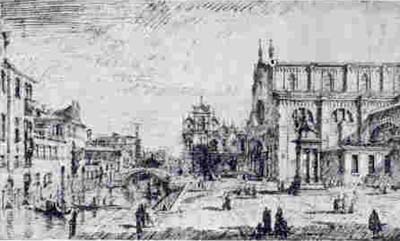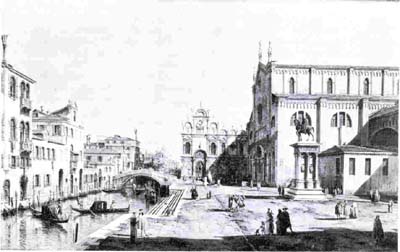
Bulletin 9-10 (V:1-2), 1967
Home
Français
Introduction
History
Annual Index
Author &
Subject
Credits
Contact



Bernardo
Bellotto's Venetian Period (1738-1743)
by Professor Terisio
Pignatti, Vice-Directore
Musei Civici Veneziani
Résumé en français
Pages 1 | 2
| 3 | 4
In 1965 the distinguished Venetian scholar, Terisio
Pignatti, visited the Montreal Museum of Fine Arts where the
Canaletto exhibition, arranged by the Art Gallery of Toronto and
shared with the National Gallery of Canada and the Montreal Museum,
was on display. He was attracted by four works, two of them in the
collection of the National Gallery, which he felt were by
Canaletto's nephew, Bellotto. He used them as the basis for
examining Bellotto's early work and in 1966 published the results
in Arte Veneta, which has generously given us permission to reprint
this article in translation with slight revisions by the author.
During the summer of 1967 one of the National Gallery's pictures,
the Piazzetta Looking North, was exhibited in Venice in I Vedutisti
Veneziani dei Settecento as a work by Bellotto.
After having seen the exhibitions of works by Canaletto in Canada
and by his nephew, Bellotto, in Vienna in 1965, I felt that a
distinction should be made between Bellotto's early work and his
uncle's, if only as an incentive to future research. (1)
The statement that it is difficult to distinguish Bellotto's
Venetian works from Canaletto's has become one of the characteristic
platitudes about eighteenth-century Venetian painting. Apparently,
Guarienti, Bellotto's first biographer, was also the first to make
this statement. In Pellegrino Orlandi's Abecedario pittarica, he
wrote: "Bernardo Bellotto was from a well-to-do family. He was
taught the principles of art by his uncle, Antonio Canal, and after
having mastered these principles, began to imitate him with
diligence. On the advice of his uncle he went to Rome to improve his
style by drawing and painting the ancient ruins and the most
beautiful views of that noble city. With all this practice, he
became more skillful and returned to Venice. He then depicted the
most important sites of Venice, Brescia, Verona and Milan. His
scenes of Venice were so carefully and so realistically done that it
was exceedingly difficult to distinguish his work from his
uncle's." (2)
Bellotto was thus painting "carefully" and drawing
"realistically" while he was a member of the Brotherhood
of Venetian Painters from 1738 to 1743. To his contemporaries his
style seemed almost identical with that of his uncle and teacher.
There are, however, very few works from this period that have been
confirmed as his. The first reference made to his artistic activity
is in an inscription on a drawing in the Darmstadt Museum (AE 2218),
"Campo S. Giouani paullo, li 8 Deccemb 1740 Feccit Bernardo
Bellotti
(plate 1) .The relationship of this drawing to an almost
identical one by Canaletto in the Windsor Collection (No. 7481)
(plate 2) has been interpreted in different ways: in the past,
Bellotto's drawing was considered to be a copy of Canaletto's; (3)
Constable suggests that it could be a copy of a lost sketch by
Canaletto for a painting in the National Gallery in Washington; (4)
Kozakiewicz believes that it probably preceded Canaletto's, and
proposes that Bellotto could have acted as a "graphic
reporter" for the whole studio. (5) I am now convinced that
Bellotto's drawing is not dependent upon Canaletto's but that they
were made at the same time, one by the famous uncle and the other by
the young nephew, not yet 20 years old. (6)
Before analysing this relationship any further, I should like to
mention something about Bellotto's early activity. I have not been
able to find any record of what he did during the rest of the time
he spent in Venice. The first definite date is 1744 and is found in
an inscription on a drawing in Warsaw (folio No. 2039) of the View
of Vaprio d'Adda
(which is related to a painting in the Metropolitan
Museum). By then Bellotto was outside Venice and preparing for the
long European tour from which he would not return. Meanwhile his
uncle went to England, and the close relationship between the two
artists was severed.
There are many paintings, however, that are attributed to Bellotto
because of style and to his early period because of subject matter.
Kozakiewicz and Pallucchini mention the two Capricci from the museum
in Asolo; (7) the Campo SS. Giovanni e Paolo from the Museum of Fine
Arts, Springfield, Massachusetts (plate 3); various
Views of
Florence
in the museum in Budapest, in the Fitzwilliam Museum in Cambridge,
and in Boston's Museum of Fine Arts; the
View of Rome
in the Detroit
Institute of Arts. From his Roman period of 1742, there are four
canvases in Parma, The Roman Aqueduct, the Capriccio Romano, the
Campidoglio and the Coliseum,
in addition to others in museums and
private collections. (8) Scenes of Venice like the
Miracoli
which was
formerly in the Castiglioni collection in Venice are rarer. (9)
Up to this point the attribution of these works to Bellotto does not
conflict with Canaletto's works, and suggests that Guarienti's
preoccupation with the "great connoisseurship" necessary
to distinguish them from his uncle's was exaggerated. It appears
strange, however, that with such a substantial group of paintings
attributed to Bellotto in the years 1738-43, the point has not been
pursued and comparisons have not been made with the body of
Canaletto's work about 1740. This is what we did in examining the
material in the Canadian and Viennese exhibitions.
What then are the characteristics that make it difficult to
distinguish Bellotto's Venetian works from Canaletto's? If we return
to his drawing from Darmstadt of 1740 (plate 1) and to the
remarkably similar drawing by Canaletto from Windsor (plate 2) we
find the two artists expressed the same subject matter using very
similar techniques. The point of view was, however, slightly
different, as though they were drawing from adjoining windows; this
gives some indication of the way the studio was run in the 1740's.
It is also known that Canaletto would make rough sketches and
detailed drawings at the site, and then make the finished drawings
and paintings in the studio. (10)
Next Page | Bellotto
and Canaletto's styles
1 | 2
| 3 | 4
Annual Index | Author & Subject | Credits | Contact
This digital collection
was produced under contract to Canada's Digital Collections program,
Industry Canada.
"Digital
Collections Program, Copyright
© National Gallery of
Canada 2001"